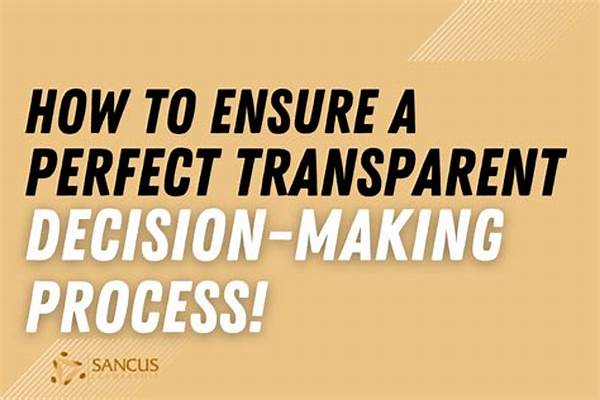Hey there, fellow decision-makers! Let’s dive into a subject that’s close to my heart and, I believe, should be close to yours as well—transparency in decision-making. You see, as I stagger through the daily grind of life, one thing I constantly remind myself about is how much smoother everything runs when we all know what’s going on. Imagine a world where decisions are made, not in secrecy, but with openness, clarity, and mutual understanding. Sounds dreamy, right?
Read Now : Romantic Getaways For Adventurous Couples
Why Transparency Matters
So, why should we put emphasis on cultivating transparency in decision-making, you ask? Let’s be real—life is a series of decisions, whether we like it or not. From deciding what coffee to order to those major life-changing calls, we are all bombarded by choices every single day. But here’s the kicker: when too much is kept hidden, or if communication is poor, confusion can reign supreme. Transparency, my friends, acts like a beacon, lighting the path so everyone involved is on the same page, making informed decisions easier and more effective. And trust me, that makes things a whole lot less chaotic and more satisfying for all parties involved.
Besides, cultivating transparency in decision-making fosters trust. Whether it’s between leaders and team members, spouses, friends, or businesses and consumers, that foundation of openness makes everything smoother. When people understand the “why” behind decisions, there’s less room for doubt and more space for trust to grow. And let’s not ignore the snazzy side effect: transparency can seriously boost accountability.
Steps to a Transparent Decision-Making Process
1. Open Communication Channels
Cultivating transparency in decision-making starts with creating channels where everyone’s voice can be heard. It’s like an open-mic night but with more responsibility!
2. Clarify the Decision’s Purpose
Explaining reasons behind decisions can clear up so much confusion. Trust me, everything makes much more sense when you know the “why” behind it.
3. Share Information Freely
Don’t hoard information. Cultivating transparency in decision-making means painting the whole picture, not just the parts you’re comfortable sharing.
4. Invite Diverse Perspectives
The more, the merrier! Involving a wide range of perspectives ensures that the decision effectively caters to everyone’s interests.
5. Regular Feedback Sessions
Read Now : Importance Of Greenspaces In Cities
This is crucial. Regular feedback loops mean everyone can say, “Hey, this isn’t working!” and adjustments can be promptly made.
Addressing Common Challenges
Even when we know how crucial it is, cultivating transparency in decision-making can face its own set of hurdles. Ever had that moment where you felt like there was an “elephant in the room” no one was acknowledging? This is one of those moments when transparency is needed but can be a challenge to establish. It’s imperative to recognize these hurdles such as secrecy traps, fear of backlash, and the temptation to withhold disappointing news.
To get around this, encourage transparency as a cultural norm. Making transparency a part of the very fabric of an organization or a relationship can mitigate roadblocks. Regular training, workshops, and active dialogues, where honesty is cherished, can go a long way. By consistently repeating the mantra of cultivating transparency in decision-making, over time, it becomes second nature.
Defining Transparency with Real Stories
To truly understand the beauty of cultivating transparency in decision-making, let’s delve into some real-world anecdotes. I recall a time when a friend who leads a team of creators decided to shift the team’s direction. Instead of keeping it hush-hush, she laid out the data, shared her rationale, and opened the floor for feedback. Not only did this make her crew feel valued, but it also resulted in zero confusion and a much-smoother transition!
Imagine a company facing a downsizing decision. They choose to communicate every step, ensuring employees understand the financial pressures at play. True, the situation wasn’t ideal, but the understanding and mutual support cultivated through transparency made an incredibly tough call a bit easier on everyone.
Strategies for Building a Transparent Culture
When I think of cultivating transparency in decision-making, strategies are the bread and butter. It starts with a commitment from the top, with leaders modeling transparent behavior. And no, this doesn’t mean spilling every tiny detail but sharing enough to make sense of the bigger picture. Mixed messaging? No thanks.
Next up, you want tools and processes. Use platforms that encourage dialogue, be it online forums or team meet-ups. Celebrate transparency victories—nothing like a “transparency champion” award to keep the spirits high! In an atmosphere where everyone feels safe to voice thoughts and hear others’ perspectives, transparency blossoms.
Final Thoughts on Transparency
Alright, let’s wrap this up. If you’re looking to make your life or organization run more smoothly, start integrating transparency in your decision-making process. It isn’t just about making decisions public but ensuring all involved have the info they need to understand and participate in those decisions effectively. It builds trust, fosters understanding, and yes, it can make even the toughest calls a little less daunting.
In the end, cultivating transparency in decision-making isn’t just a strategy—it’s a mindset. When decision-making is aligned with transparency, it opens doors, breaks down barriers, and encourages collaboration. So, my friends, let’s commit to shedding light on the path ahead, cultivating honesty and openness. Because with transparency, we not only make better decisions, but also build stronger connections every step of the way.



